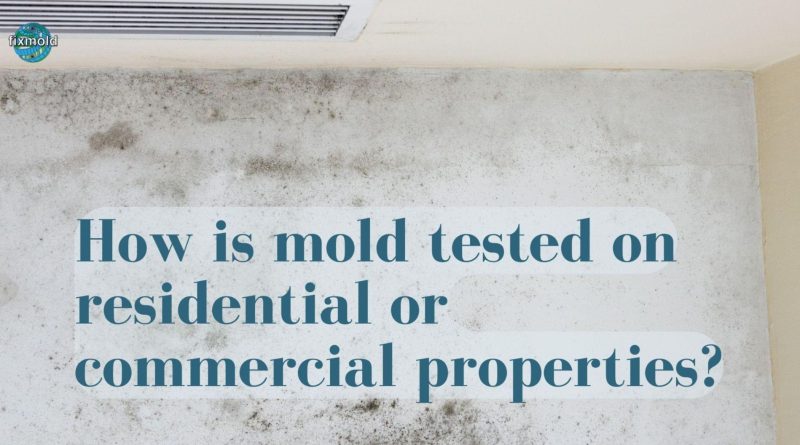How is mold tested on residential or commercial properties?
If you are a homeowner with a damp, dark basement or an apartment dweller who regularly sees leaks in the ceiling, you may be concerned about mold growing in your home. Mold thrives on moisture. In fact, even small amounts of standing water can create the perfect environment for mold to grow. Unfortunately, homeowners and renters often don’t know they have mold until its spores become airborne and release musty odors throughout the house. Although many people believe that all molds are dangerous, this is not true. Experts now recognize that some types of mold are actually beneficial to human health. However, given the right conditions — especially moisture — these types of molds could also thrive in your home. It’s worth noting that only certain types of molds produce mycotoxins, which are toxic secondary metabolites produced by many fungi species; not all molds pose risks to human health or indoor air quality.
What is Mold?
Mold is a type of fungus that can grow almost anywhere there is moisture and decaying organic matter. It’s commonly found in soil, food, and on the walls of our homes. When you see it, you’re just seeing the fruiting bodies of the fungus, the part of the plant that releases spores. The spores are what float in the air and make people sick. Molds release tiny spores, which are so light they can float through the air and settle on almost any surface. When the spores land on something that’s damp and has the right temperature, they can start to grow.
How to Detect Hidden Mold in Your Home

If you suspect your home may be infected with mold, the first step is to find it. Here are a few places you can look: – Damp or wet areas – Perhaps the most visible sign of mold is water stains. You may notice an increase in dampness in areas of your home where water is commonly seen, such as basements, bathrooms, and kitchens. You may also find that walls, ceilings, and other surfaces are covered in black or blue mold. Mold grows best in warm, humid environments and needs water to survive. If you see signs of dampness in your home, it’s worth investigating further to determine if there is a water issue. – Peeling wallpaper – Another sign of mold is peeling wallpaper. The spores can travel through your home’s ventilation system and settle on your walls, where they will start growing. If you notice peeling wallpaper, especially if you’ve had recent water damage, it’s worth investigating further to determine if there is mold behind it.
Test for Visible Molds: Which Test Should You Choose?
If you have visible mold in your home, you’ll want to test for it to determine what type of mold it is. A laboratory analysis of a sample of the mold can provide you with information about what species it is, what harmful toxins it produces, and what conditions will allow it to flourish. To sample for mold, you can use a swab or a sample bag. Both are easy to use and will give you the data you need to determine the best course of action. Keep in mind that sampling for mold can be a bit tricky. If you sample incorrectly, you could end up with false results. Here are a few tips for sampling for mold: – Select an appropriate sample – Because not all molds are bad, it’s important to select an appropriate sample. You should select a sample that is representative of the mold you’re trying to identify, so you can get accurate results. – Sample in an appropriate environment – You should sample in an environment that allows the mold to be exposed, while avoiding direct contact with people and other indoor materials. – Avoid disturbing the sample – Remember that you’re trying to sample a representative piece of the mold, so you don’t want to disturb the sample. – Sample in a contained environment – In order to prevent cross-contamination, you should sample in a contained environment. You can use a sample bag to prevent cross-contamination by containing your sample.
Test for Hidden Mold: Sampling Strategy
If you can’t find visible mold in your home, but you still think it’s there, you may want to sample for hidden mold. To sample for hidden mold, you’ll want to take a two-pronged approach: – Use a sample bag – You can use a sample bag for surfaces you don’t want to disturb, such as drywall, carpet, and fiberglass insulation. – Choose your sample wisely – You should only sample areas where you believe mold is present. If you sample areas that are clean, you could end up with false results. – Consider hiring a professional – If you’re unsure of the best way to sample for hidden mold, you may want to consider hiring a professional who can help you select the right areas to sample.
Conclusion
If you suspect that your home is infected with mold, you should hire a professional to inspect and test your home. Most homeowners’ insurance policies require that the insurance company cover the cost of mold remediation. Keep in mind that it’s not always easy to detect mold, especially in older homes with poor ventilation. If you think your home may be infected with mold, you should act quickly to find it and remove it before it spreads.


